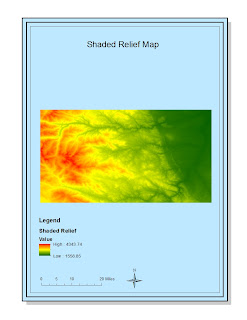Lab 7: Using Census 2000 Data
The map above is a map showing the distribution of Black people living in the United States, according to data from the U.S. Census of 2000. The largest populations are in The South-with a large concentrated area in the Lower Mississippi Delta region. Additionally, there are cities in the Midwest and Northeast that show larger black populations. The range of percentage of the total population is 0-86.5%.
The map above is a map showing the distribution of Asian people living in the United States, according to data from the U.S. Census of 2000. The Asian population of the United States are located in small areas of the U.S., mostly along the East and West coasts. The biggest concentrations of Asian people exist in Southern California and the Bay Area. The Asian population appears to be the least widespread of the racial groups I mapped. The range of percent of the total population is 0-46%.
The map above is a map showing the distribution of "Some Other Race" people living in the United States, according to data from the U.S. Census of 2000. I assume that "Some Other People" is a representation of the Latino distribution; Much of the higher concentration of "Some Other Race" is located around the Southwest border region. The highest concentrated areas are in California, New Mexico, and Texas. The range of percent of the total population is 0-40%.
Using Census data to create maps is a great source of free and public data. The data is more than 10 years old so the map is definitely a bit misrepresentative of the United States' racial makeup of today. There are some errors in the maps above where some counties have no officially reported information. This missing data appears as white on the maps in the counties that have no inputed data. The percentage of total race data is interesting information to map. However, it is important to note that this map doesn't show the areas with the most people of a particular race. Shown are the areas with the most people of a particular race in relation to the total population in a county.
My overall experience using ArcGIS to produce maps has been both stressful and enlightening. This lab was pretty simple and similar to the assignments we've completed before. We learned how to join Census data to an already existing data set. We also were introduced to working and editing data in a set in order to make it compatible with the ArcGIS software. This set up the issue of making sure the data is joined correctly. I am impressed with the variety of uses this software has made thus far. I can say I'm no longer afraid of ArcGIS, and I feel more comfortable creating maps.










